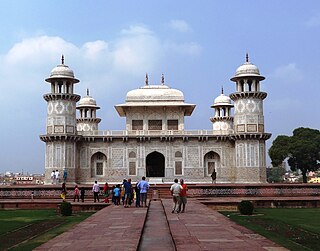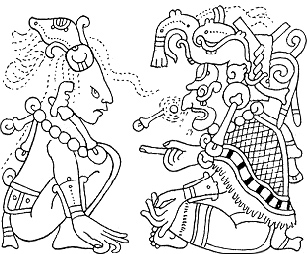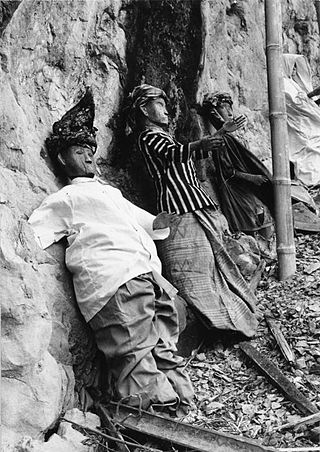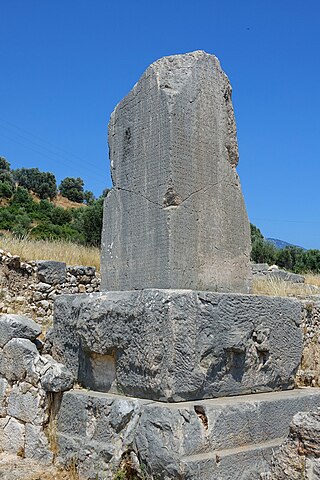
The veneration of the dead, including one's ancestors, is based on love and respect for the deceased. In some cultures, it is related to beliefs that the dead have a continued existence, and may possess the ability to influence the fortune of the living. Some groups venerate their direct, familial ancestors. Certain religious groups, in particular the Eastern Orthodox Churches, Catholic Church and Anglican Church venerate saints as intercessors with God; the latter also believes in prayer for departed souls in Purgatory. Other religious groups, however, consider veneration of the dead to be idolatry and a sin.

A tomb is a repository for the remains of the dead. It is generally any structurally enclosed interment space or burial chamber, of varying sizes. Placing a corpse into a tomb can be called immurement, although this word mainly means entombing people alive, and is a method of final disposition, as an alternative to cremation or burial.

The ancient Egyptians had an elaborate set of funerary practices that they believed were necessary to ensure their immortality after death. These rituals included mummifying the body, casting magic spells, and burials with specific grave goods thought to be needed in the afterlife.

A church monument is an architectural or sculptural memorial to a deceased person or persons, located within a Christian church. It can take various forms ranging from a simple commemorative plaque or mural tablet affixed to a wall, to a large and elaborate structure, on the ground or as a mural monument, which may include an effigy of the deceased person and other figures of familial, heraldic or symbolic nature. It is usually placed immediately above or close to the actual burial vault or grave, although very occasionally the tomb is constructed within it. Sometimes the monument is a cenotaph, commemorating a person buried at another location.

The Tomb of the Roaring Lions is an archaeological site at the ancient city of Veii, Italy. It is best known for its well-preserved fresco paintings of four feline-like creatures, believed by archaeologists to depict lions. The tomb is believed to be one of the oldest painted tombs in the western Mediterranean, dating back to 690 BCE. The discovery of the Tomb allowed archaeologists a greater insight into funerary practices amongst the Etruscan people, while providing insight into art movements around this period of time. The fresco paintings on the wall of the tomb are a product of advances in trade that allowed artists in Veii to be exposed to art making practices and styles of drawing originating from different cultures, in particular geometric art movements in Greece. The lions were originally assumed to be caricatures of lions – created by artists who had most likely never seen the real animal in flesh before.

Death rituals were an important part of Maya religion. The Maya greatly respected death; they were taught to fear it and grieved deeply for the deceased. They also believed that certain deaths were more noble than others.

The culture of Madagascar reflects the origins of the Malagasy people in Southeast Asia, East Africa and Oceania. The influence of Arabs, Indians, British, French and Chinese settlers is also evident.

Funerary art is any work of art forming, or placed in, a repository for the remains of the dead. The term encompasses a wide variety of forms, including cenotaphs, tomb-like monuments which do not contain human remains, and communal memorials to the dead, such as war memorials, which may or may not contain remains, and a range of prehistoric megalithic constructs. Funerary art may serve many cultural functions. It can play a role in burial rites, serve as an article for use by the dead in the afterlife, and celebrate the life and accomplishments of the dead, whether as part of kinship-centred practices of ancestor veneration or as a publicly directed dynastic display. It can also function as a reminder of the mortality of humankind, as an expression of cultural values and roles, and help to propitiate the spirits of the dead, maintaining their benevolence and preventing their unwelcome intrusion into the lives of the living.

In the burial practices of ancient Rome and Roman funerary art, marble and limestone sarcophagi elaborately carved in relief were characteristic of elite inhumation burials from the 2nd to the 4th centuries AD. At least 10,000 Roman sarcophagi have survived, with fragments possibly representing as many as 20,000. Although mythological scenes have been quite widely studied, sarcophagus relief has been called the "richest single source of Roman iconography," and may also depict the deceased's occupation or life course, military scenes, and other subject matter. The same workshops produced sarcophagi with Jewish or Christian imagery. Early Christian sarcophagi produced from the late 3rd century onwards, represent the earliest form of large Christian sculpture, and are important for the study of Early Christian art.

A tomb effigy is a sculpted effigy of a deceased person usually shown lying recumbent on a rectangular slab. Although these funerary and commemorative reliefs were first developed in Ancient Egyptian and Etruscan cultures, they appear most numerously in Western Europe tombs from the later 11th century, in a style that continued in use through the Renaissance and early modern period, and are still sometimes used. They typically represent the deceased in a state of "eternal repose", with hands folded in prayer, lying on a pillow, awaiting resurrection with a dog or lion at their feet. A husband and wife may be depicted lying side by side.

The Vazimba, according to popular belief, were the first inhabitants of Madagascar. While beliefs about the physical appearance of the Vazimba reflect regional variation, they are generally described as smaller in stature than the average person, leading some scientists to speculate that they may have been a pygmy people who migrated from the islands that constitute modern-day Indonesia and settled in Madagascar over the course of the period between 350 BCE–500 CE. Scientific evidence confirms the first arrival and subsequent increase of human settlers on the island during this period, but the pygmy theory has not been proven.

The architecture of Madagascar is unique in Africa, bearing strong resemblance to the construction norms and methods of Southern Borneo from which the earliest inhabitants of Madagascar are believed to have immigrated. Throughout Madagascar, the Kalimantan region of Borneo and Oceania, most traditional houses follow a rectangular rather than round form, and feature a steeply sloped, peaked roof supported by a central pillar.

The Mahafaly are an ethnic group of Madagascar that inhabit the plains of the Betioky-Ampanihy area. Their name means either "those who make holy" or "those who make happy", although the former is considered more likely by linguists. In 2013 there were an estimated 150,000 Mahafaly in Madagascar. The Mahafaly are believed to have arrived in Madagascar from southeastern Africa around the 12th century. They became known for the large tombs they build to honor dead chiefs and kings. Mainly involved in farming and cattle raising, they speak a dialect of the Malagasy language, which is a branch of the Malayo-Polynesian language group.
The Tandroy are a traditionally nomadic ethnic group of Madagascar inhabiting the arid southern part of the island called Androy, tracing their origins back to the East Africa mainland. In the 17th century however, the Tandroy emerged as a confederation of two groups ruled by the Zafimanara dynasty until flooding caused the kingdom to disband around 1790. The difficult terrain and climate of Tandroy protected and isolated the population, sparing them from subjugation by the Kingdom of Imerina in the 19th century; later, the French colonial authority also struggled to exert its influence over this population. Since independence the Tandroy have suffered prejudice and economic marginalization, prompting widespread migration and intermarriage with other ethnic groups, and leading them to play a key role in protests that sparked the end of President Philibert Tsiranana's administration in 1972.

Tau tau are a type of effigy made of wood or bamboo. They are particular to the Toraja ethnic group in South Sulawesi, Indonesia. The word "tau" means "man", and "tau tau" means "men" or "statue".

The funerary art of ancient Rome changed throughout the course of the Roman Republic and the Empire and took many different forms. There were two main burial practices used by the Romans throughout history, one being cremation, another inhumation. The vessels used for these practices include sarcophagi, ash chests, urns, and altars. In addition to these, mausoleums, stele, and other monuments were also used to commemorate the dead. The method by which Romans were memorialized was determined by social class, religion, and other factors. While monuments to the dead were constructed within Roman cities, the remains themselves were interred outside the cities.

Tang dynasty tomb figures are pottery figures of people and animals made in the Tang dynasty of China (618–906) as grave goods to be placed in tombs. There was a belief that the figures represented would become available for the service of the deceased in the afterlife. The figures are made of moulded earthenware with colour generally being added, though often not over the whole figure, or in naturalistic places. Where the colouring was in paint it has often not survived, but in many cases it was in sancai ("three-colour") ceramic glaze, which has generally lasted well.

The theme of death within ancient Greek art has continued from the Early Bronze Age all the way through to the Hellenistic period. The Greeks used architecture, pottery, and funerary objects as different mediums through which to portray death. These depictions include mythical deaths, deaths of historical figures, and commemorations of those who died in war. This page includes various examples of the different types of mediums in which death is presented in Greek art.

Egyptian finger and toe stalls are pieces of gold jewelry used in Ancient Egypt to protect digits during burial. Such stalls were used during the 18th Dynasty of Egypt, as well as other eras, and were thought to protect the deceased from both magical and physical dangers, such as damage which could occur during the mummification process. Additionally, they were sometimes used in order to replace missing digits on the deceased, as it was believed that a complete body was needed for successful passage into the afterlife. This belief mirrors the myth of Osiris, whose body was put back together by his wife Isis, resulting in him becoming the first mummy. Some mummies were buried with prosthetics which they used in life, rather than toe stalls created specifically for burial. These stalls were most commonly found on the remains of royalty. Toe stalls were discovered in the tomb of Tutankhamun, and a nearly complete set of finger and toe stalls was discovered in the tomb of three of the wives of Thutmose III in Thebes. The wives' jewelry is currently on display at the Metropolitan Museum of Art. The stalls from this tomb are some of the earliest known, originating from the early 18th Dynasty. A later surviving example of toe stalls comes from the tomb of Psusennes I, a 21st Dynasty ruler. Although many surviving examples of finger and toe stalls originate from the 18th Dynasty, they were used for much of Ancient Egypt, including into the Ptolemaic and Roman periods. For example, one mummy from this period was found with carved golden finger stalls, similar to those discovered from earlier periods. Though royalty and the upper classes typically had stalls made of gold or silver, less wealthy Egyptians utilized other materials, including wood, stone, and/or mud. In order to provide magical protection for the deceased, a prayer was made to Osiris as the stalls were created. The stalls were often highly detailed, with carved nails and other features, such as rings.

Chinese burial money a.k.a. dark coins are Chinese imitations of currency that are placed in the grave of a person that is to be buried. The practice dates to the Shang dynasty when cowrie shells were used, in the belief that the money would be used in the afterlife as a bribe to Yan Wang for a more favourable spiritual destination. The practice changed to replica currency to deter grave robbers, and these coins and other imitation currencies were referred to as clay money (泥錢) or earthenware money (陶土幣).


















